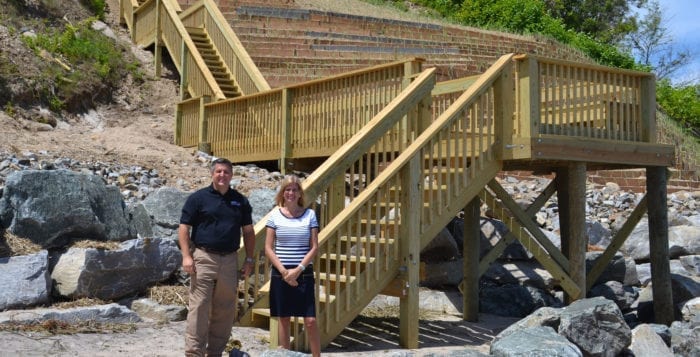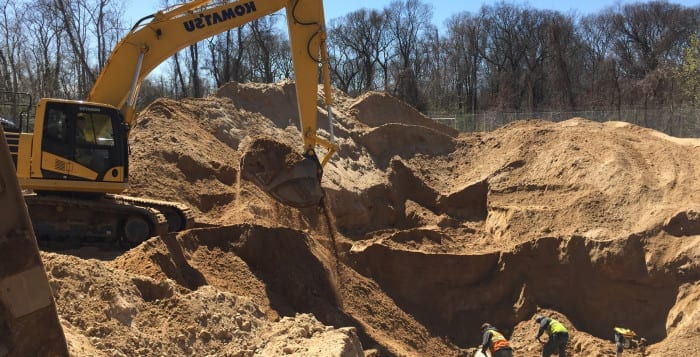Sound Beach’s shoreline is now stabilized.
In October 2012, Hurricane Sandy changed the typography of much of the North Shore’s beaches and dunes. In Sound Beach, the bluff at Shore Road and Amagansett Drive became severely eroded. With roads and homes at risk, the Town of Brookhaven Highway Department began a four-year, multiphase $1.3 million project in May 2013 to steady it.
“The hardening of our infrastructure leaves us less vulnerable to damage from future storms,” Highway Superintendent Dan Losquadro (R) said. “In the long run, the results of this project will save taxpayer dollars due to fewer erosion costs in the area.”
To stabilize the bluff, almost 2,000 cubic yards of clean fill was added and an outfall pipe replaced, which broke during Hurricane Sandy. The work was approved by the Federal Emergency Management Agency, and $233,651 in federal assistance was received to help with the cost of the project.
The work on the bluff and the repair of the pipe were never meant to complete the project, but, according to Losquadro, was just a first phase.
“In the long run, the results of this project will save taxpayer dollars due to fewer erosion costs in the area.”
— Dan Losquadro
“It was just a temporary ‘Band-Aid’ so the bluff wouldn’t erode any further and jeopardize the structural integrity of the drainage pipe,” he said. “Our ultimate goal was to eliminate the outfall over the bluff completely, abandon the drainage pipe and direct all of the water from this stream into a newly constructed recharge basin to the east of Amagansett Drive.”
He said the project offered the town the rare ability to eliminate an outfall pipe, preventing stormwater runoff from flooding the beach and entering the Long Island Sound, while also taking erosion pressure off the face of the bluff.
Once construction of the recharge basin near the intersection of Amagansett Drive and Shore Drive was completed in 2015, the final phase of the project began, which included the abandonment of the pipe and permanent stabilization of the bluff through the installation of a three- to four-ton armoring stone revetment wall, erosion control matting, wood terracing and native plantings. The project also included the installation of a new staircase from Shore Drive.
“As a town, we need to make sure there is reliable access that will be there season after season for our fire department and police in the event of an emergency,” Losquadro said.
This phase was completed with in-house resources and came in under budget.
Although the temporary stabilization of the bluff received funding from FEMA, the storm hardening and total bluff restoration was paid for through town capital funds. The total cost for Phase II — construction of the recharge basin — was $633,333 and for Phase III — storm hardening and bluff restoration — was $450,000.
“Completion of this project on time and under budget after being stalled by [Hurricane] Sandy is a welcome event to the residents of Sound Beach,” Brookhaven Town Councilwoman Jane Bonner (C-Rocky Point) said. “The bluffs along the North Shore are especially vulnerable to erosion, but the more we can do to stabilize our shoreline, the safer it will be.”






